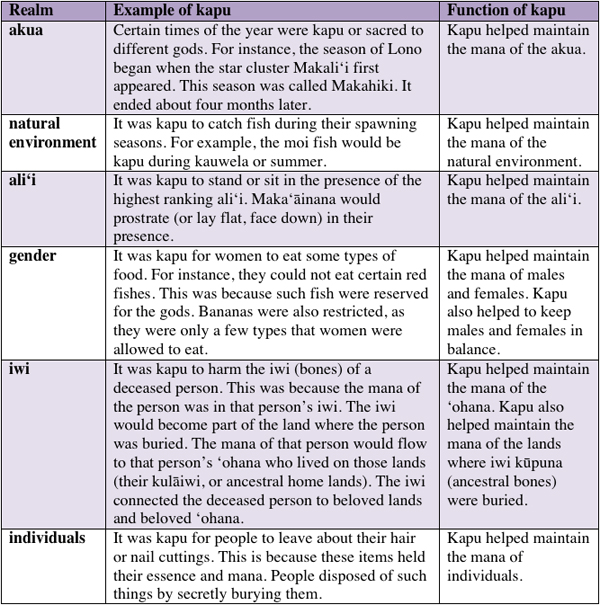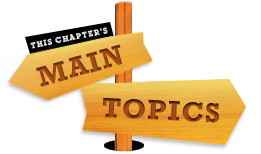Kapu— ʻŌlelo Noʻeau #2451ʻO ke ali‘i lilo i ka leʻaleʻa a mālama ‘ole i ke kanaka me ke kapu akua, ‘aʻole ia he aliʻi e kū ai i ka moku.The chief who is taken with pleasure-seeking and cares not for the welfare of the people or the observation of the kapu of the gods, is not the chief who will become a ruler.
Read the signs
Imagine hiking through Waipi‘o Valley on Hawai‘i Island. You are without a local friend or guide (bad move!). You take a detour off the main trail (not a good idea!) and see a tree with a sign that says, “Kapu, no trespassing.” Uh oh! What do you do? Should you run for your life? Take cover from flying objects? Should you even be there in the first place?
Even if you don’t know what “kapu” means, you can tell by the rest of the sign that you are not allowed to be in that area.
![[Kapu sign] Photo by Charles O Rear, EPA.](/unit-assets/kapu_image_01.jpg)
Kapu, like all of our words, has several meanings. Today, when you see it near an entrance to a place, it usually means the place is off limits. But what makes a place kapu today may be different from before.
Traditionally, there were ali‘i, or chiefs, whose rank was so high, they were considered kapu, or sacred. Everything about the ali‘i was kapu. Their homes were kapu. Their eating bowls were kapu. Their bodies were kapu. Even their shadows could be kapu.
In order to protect that which was kapu, the gods made laws. People needed to follow those laws. The laws are called “kapu.” If you think you’re seeing double, you are. “Kapu” refers to something sacred and it refers to the laws established to protect the sacred. So the kapu protected that which was kapu. Get ‘em, got ‘em, good?
Kapu enforcement
Breaking the kapu was punishable. A small infraction would bring a small penalty. A serious violation would bring a heavy penalty. If someone stole offerings for a god, there would be a serious punishment. If someone entered the residence of an ali‘i kapu, there could also be a serious punishment.
And so, when a kapu was pronounced upon a place, it was to protect not only the ali‘i but also the people who might be severely punished for being in the wrong place.
Ali‘i nui, or ruling chiefs, were responsible for enforcing kapu. They could use the death penalty for someone who broke a most important kapu. The ali‘i nui assigned lesser chiefs to help with maintaining kapu in different parts of an island. Haku, who were the leaders of ‘ohana, helped maintain kapu in the ‘ohana. Individuals were also responsible for following kapu.
No rules, just noa
The opposite of kapu is noa. Something noa is free of rules.
People could be noa or kapu. Maka‘āinana were ordinary citizens. They were noa. Ali‘i were leaders and rulers. They were kapu. Ali‘i could trace their lineage to the gods. Maka‘āinana could not. Kapu protected ali‘i. Kapu determined how maka‘āinana could approach ali‘i.
Profound power
Why are some things kapu and some not? It has to do with mana. Mana is the power from the gods. Mana and kapu are closely related. Something that has a lot of mana is kapu.
![[Moi in offshore cage] Photo courtesy of NOAA, Fisheries Collection.](/unit-assets/kapu_image_03.jpg)
Can fish have mana? Yes, in fact, a moi that is full of eggs has much mana. Its eggs can produce hundreds of fish. As the fish grow, they feed bigger fish or people. This ability to create future abundance gives much mana to moi during their spawning season. It’s what also makes them kapu at that time. When moi are kapu, a kapu is placed on them to prevent fishermen from catching and keeping them. The kapu placed on moi ensures that moi can lay their eggs. The kapu also ensures that there are many moi in the future. When moi are not kapu, they are noa, which is most of the year.
High-ranking ali‘i held great mana. They descended from the gods and were trained to be wise rulers. They knew how to manage their lands so the lands would be prosperous. They knew how to manage their people so the people could work well together. They learned history to continue what was good and avoid what was bad. Ali‘i were also raised to care deeply for their gods, lands, and people. They played a vital role in the society. For all these reasons, ali‘i held great mana. Their mana made them kapu. The kapu protected them so they could care for the gods, land, and people.
Why kapu?
Kapu fostered a healthy society. Kapu did this by keeping order and balance in the society. People knew what they could and could not do. When people followed kapu, the society was rich with mana. The world thrived.
What would happen if there were no kapu? Relationships between people, gods, and nature might be broken. The world might get out of balance. An imbalanced world might not have enough moi fish. Fewer moi means less to eat for us and for fish that eat moi. In the absence of moi, other fish would be eaten, and their numbers might be depleted. It could have an impact up and down the food chain. An entire species (or more) might become extinct.
Different kapu and their function
Traditionally, there were different kapu for different aspects of our world. Each had an important function. Check out the table below:

Kapu today
Today, some kapu are still in effect. There are a lot of different ways the kapu are understood and enforced. In the hula tradition, there are kapu that regulate actions and behavior. Dancers don’t ‘oki (cut) their hair and nails because they don’t want important knowledge to be cut off. They also avoid eating he‘e (octopus) and kūpe‘e (sea snail) because the names of those creatures have other meanings that might cause knowledge to he‘e (slip away) or pe‘e (hide).
Fishermen still observe the kapu on fish that are spawning. They do this by targeting fish that are not spawning. And, if they accidentally catch an egg-bearing fish, they release it. These kapu continue to help us find balance in our world.
Our Hawai‘i society has changed a lot, but we can see many similarities between traditional kapu and today’s laws. Both are formal rules that the government enforces. Both foster a healthy society. They are also similar regarding violations. Small violations receive small penalties. Large violations receive large penalties. Another similarity is that the greatest violations could result in the death penalty. Although Hawai‘i does not use the death penalty, other states in the United States do.
![[Kapu danger sign] Photo by Forest & Kim Starr.](/unit-assets/kapu_image_07.jpg) There are also differences between traditional kapu and today’s laws. A big difference is that there are thousands of laws today. In the past, there were far fewer kapu. Another difference is the role of the gods in laws. Today’s laws generally do not address spiritual matters. Kapu had everything to do with mana and spiritual matters.
There are also differences between traditional kapu and today’s laws. A big difference is that there are thousands of laws today. In the past, there were far fewer kapu. Another difference is the role of the gods in laws. Today’s laws generally do not address spiritual matters. Kapu had everything to do with mana and spiritual matters.
So when you see a sign that says “Kapu,” you know that there are reasons to keep your distance. Learn more about the place and the reason the sign is there. And maybe the next time you visit that place, you’ll notice things you didn’t see before.

Did you know that many kapu live on in State of Hawai‘i laws relating to fishing? As in times past, current laws place kapu (or prohibitions) on fishes during their spawning seasons.
Did you know that Mā‘ilikūkahi, a ruling chief of O‘ahu who lived 12 generations before the time of Kamehameha, never punished lawbreakers with the death penalty?
Kamehameha I was the last ruling chief to maintain the kapu. Upon his passing, high ranking chiefs such as Ka‘ahumanu (Kamehameha’s wife) and Liholiho (Kamehameha’s son and heir) ended the government’s enforcement of the kapu. This occurred in 1819, the year before the first Christian missionaries arrived in Hawai‘i. However, many aspects of the kapu were and are still followed by ‘ohana.
